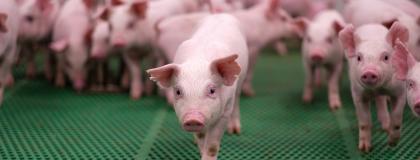
Research Uncovers Innovative Approaches to Prevent Boar Taint
Male pigs pose a dilemma for the swine industry. Uncastrated males, called boars, are very efficient at turning feed into meat, but they also bring the risk of boar taint that renders their meat inedible.
Published: Monday, April 28, 2025
Lead photo: Piglets at the Ontario Swine Research Centre
Impact
Dr. Jim Squires and his research team are developing precision approaches to predict and control boar taint, a significant issue in the swine industry. This Alliance-supported research is expected to offer Ontario producers new ways to prevent boar taint without castration, leading to double-digit gains in growth and feed conversion.
Boar taint has two components – androstenone and skatole – that produce the unmistakably strong odour and flavour released when boar meat is cooked.
To prevent boar taint, the swine industry typically castrates young male pigs physically or by using an injectable chemical.
Through decades spent studying boar taint, Dr. Jim Squires has looked for other options to reduce or eliminate the need for castration to improve animal welfare and to help pork producers capitalize on boars’ feed efficiency. Not castrating male pigs improves growth by 13 per cent, improves feed conversion by 14 per cent, and decreases feed consumption by 9.5 per cent – all putting money back in farmers’ pockets.
“If you don’t understand the mechanism of how boar taint works – and be able to measure it – you’ll never be able to solve the problem,” says Squires, a professor in the Department of Animal Biosciences at the University of Guelph’s Ontario Agricultural College. “Our ultimate goal is to control boar taint without castration and also maintain the productivity of boars."
Research unveils genetic factors in boar taint
Squires started by focusing on the function of the two active components in boar taint. Androstenone, a steroid produced in the testes, builds up in fat tissue when animals reach sexual maturity. Skatole is produced when the amino acid tryptophan breaks down in the gut.
By measuring boar taint levels at the Arkell Swine Research Facility and the new Ontario Swine Research Centre in Elora, Ont., his team discovered that the problem does not occur in every male pig. Different amounts of boar taint occur in various genetic lines, and up to 70 per cent of animals show no boar taint. “That’s a startling and significant finding that no one had looked at in the past,” says Squires.
Dr. Christine Bone, a post-doctoral researcher, is excited about the prospect of solving a problem for producers. “We’ve done a lot of work to characterize boar taint and how it develops differently in different animals, and we are now starting to look at the influence of the gut microbiome,” says Bone.
Precision approaches to predict and control boar taint
The team has focused on predicting the occurrence of boar taint and finding control options.
"One solution doesn’t work in all animals, so our strategy now is to identify biomarkers or genetic markers to know which animals are likely to respond to a particular treatment,” says Bone. “It’s a precision medicine style of approach."
By looking at these markers in young animals, producers could identify males predisposed to boar taint and adopt nutritional strategies to alter accumulation of the active components. For instance, adding binding agents to feed might alter how androstenone is metabolized and reabsorbed from the gut into the animal. Feeding fermentable carbohydrates may reduce skatole production while increasing metabolism of the substance.
“We are looking at identifying animals that respond to a particular treatment,” says Squires. “Long term, we need to develop breeding goals to eliminate boar taint. And we’re working on that as well by identifying genetic markers to predict boar taint in different breeds.”
In collaboration with Dr. Maria DeRosa at Carleton University, Squires and his team are preparing to assess a quick COVID-style test for boar taint during processing. If there are males with undescended testis (ridglings) that are found on the slaughter line, they could be tested on site to determine if the meat is free of boar taint and clear for processing. “These types of carcasses are currently discarded at processing, but if we could test a fat sample of the carcass, it could be a significant benefit for producers,” says Squires.
Testing strategies on-farm and at processing
The Ontario Swine Research Centre and a local hog processing plant are providing the testing grounds for exploring boar taint prevention options, including testing nutritional strategies, studying commercial breeding genetics and using the rapid test on carcasses at processing.
Referring to U of G’s access to the research centre, Squires says, “We are the envy of other animal science departments across Canada because of the support we receive that allows us to run these types of animal trials.”
Bone says producers are enthusiastic about the opportunity to raise boars for meat. She says, “These animals grow faster and eat less with less manure produced, which is improving environmental outcomes, too. It’s such a unique opportunity to benefit everyone involved.”
This research is funded in part by the Ontario Agri-Food Innovation Alliance, a collaboration between the Government of Ontario, Agricultural Research and Innovation Ontario (ARIO), and the University of Guelph. The Ontario Swine Research Centre is owned by the Government of Ontario through its agency, ARIO, and is managed by U of G through the Alliance. The research is also funded by the Natural Sciences and Engineering Research Council of Canada and Swine Innovation Porc under Agriculture and Agri-Food Canada’s Swine Cluster 4.

